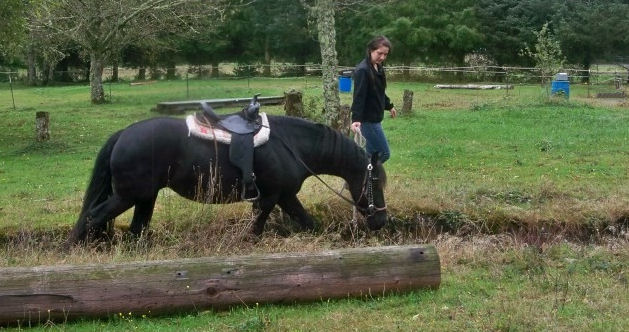One Step at a Time
by Marilyn Pineda, Fire Mountain Trail Course
I was watching a Buck Brannaman DVD a while back and he made the comment that working with our horse is like a dance. He was talking about being one-on-one with the horse, with you as the leader and your horse as the follower, dancing together. I just love that analogy! That is exactly the thrill that can be experienced when we take the time to listen to our horse as we ask him to listen to us, whether from the ground or in the saddle.
Everything we ask our horses to do and every task we are trying to achieve is a type of choreographed movement. Sometimes it is fast and dynamic; other times it is slow, and all sorts of tempos in between. Following that same train of thought is that dance steps are choreographed one step at a time and dancing partners need to learn those steps together. It is essential for each team to have a defined leader and a respective follower, but the most wonderful dances are performed when each partner is familiar with and has a working knowledge of both roles!
 This concept is great to keep in mind when bringing your horse out onto an obstacle course and approaching various challenges for the first time. For a large percentage of horses – and their humans – it is best to introduce new obstacles in hand before mounting up to ride through under saddle. Prior to asking your horse to follow your lead as you send him over a strange bridge, or to side pass across a log on a trail course, it is best to first practice the prerequisites to each specific task. From the ground, can you ask him to move forward away from you, literally one step at a time? Is he able to clearly understand what you want if you ask him to stop and stand until you ask him to continue forward, or take a step back, on a loose lead? Will he move his front quarters away from you if you give him eye contact and the motion of your hand? Can you indicate to him to move his hindquarters away from you without actually touching his rump? These are some of the basic movements to practice in preparation for challenges on a trail course.
This concept is great to keep in mind when bringing your horse out onto an obstacle course and approaching various challenges for the first time. For a large percentage of horses – and their humans – it is best to introduce new obstacles in hand before mounting up to ride through under saddle. Prior to asking your horse to follow your lead as you send him over a strange bridge, or to side pass across a log on a trail course, it is best to first practice the prerequisites to each specific task. From the ground, can you ask him to move forward away from you, literally one step at a time? Is he able to clearly understand what you want if you ask him to stop and stand until you ask him to continue forward, or take a step back, on a loose lead? Will he move his front quarters away from you if you give him eye contact and the motion of your hand? Can you indicate to him to move his hindquarters away from you without actually touching his rump? These are some of the basic movements to practice in preparation for challenges on a trail course.
The ground work may be awkward in the beginning, but if you invest meaningful time to practice these things you will soon be able to use subtle body language to obtain calm, fluid responses from your horse as you progress from one movement to another. Then, as you begin to introduce your horse to the obstacles, practice taking one step at a time in each approach to allow him to enjoy individual easy steps before the challenge of the obstacle actually starts to gets difficult! Listen to him as you advance and be aware of how much you are challenging his comfort level, and you will both gain confidence in each other as you go. Proficiency in choreographed step-by-step movements with your horse will pay off nicely when put to the test in the real world, as well. Think of the application when dealing with hesitancy or refusal for crossing a bridge or forging a stream while on a trail ride. In such a scenario, work with his hindquarters and front quarters to keep your horse facing his dilemma, on a rein that is as soft and comfortable for him as possible, to allow him to see the challenge. Then ask him to move forward one step at a time with time to relax between each step. He may do some unrequested backups to double check your leadership in the situation, but he will ultimately trust in what he has previously learned during your practice exercises.
Lead as you move, listen to your horse to find the right tempo, and the two of you will inevitably be dancing smoothly across all sorts of obstacles in beautiful harmony!
Published July 2013 Issue

The Colorado Horse Source is an independently owned and operated print and online magazine for horse owners and enthusiasts of all breeds and disciplines in Colorado and surrounding area. Our contemporary editorial columns are predominantly written by experts in the region, covering the care, training, keeping and enjoyment of horses, with an eye to the specific concerns in our region.

